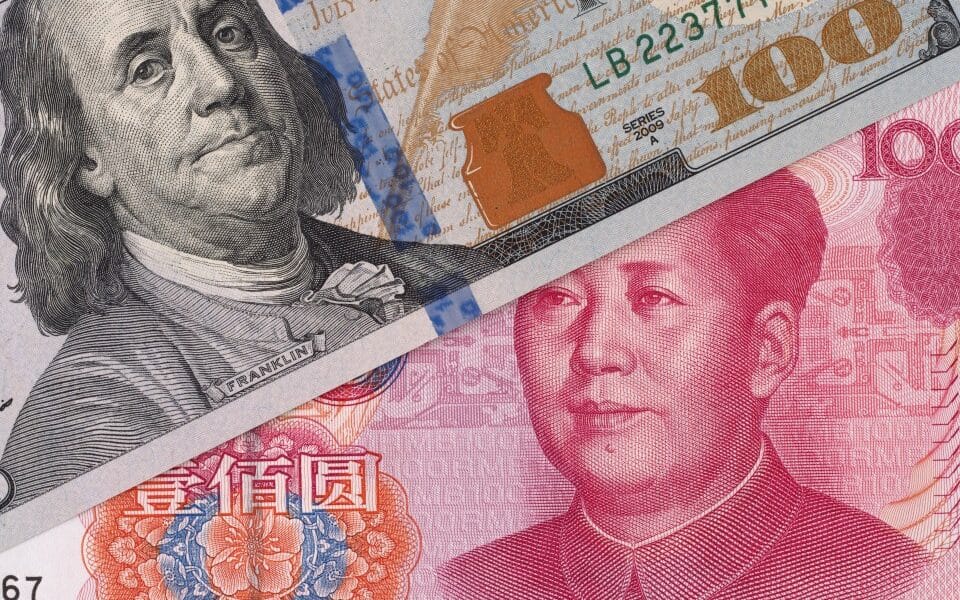China imposes 10% and 15% tariffs on U.S. imports, escalating trade tensions with Trump
China’s recent decision to impose 10% and 15% tariffs on U.S. imports increases the tensions between the two global economic giants. The announcement, made by the Chinese Ministry of Commerce, comes as a response to the tariff sanctions imposed by Donald Trump’s government on a range of Chinese products. The measure, which will take effect on February 10, 2025, will impact key sectors including energy and technology. The Chinese tariffs will be applied to items such as coal, liquefied natural gas, crude oil, agricultural machinery, and large vehicles, further escalating the trade war between the two countries and adding uncertainty to the global economy. In parallel, the Chinese government has launched an antitrust investigation against Google, intensifying the technological dispute between the nations and risking the relationship between American companies and the Chinese market.
The imposition of these tariffs by China is seen as a significant step in response to the protectionist policies of Donald Trump, who has recently imposed restrictions on Chinese imports. The immediate impact will be felt by American sectors that depend on exports to China as a crucial part of their revenue. Experts warn that the move could lead U.S. companies to seek new markets and alternative suppliers while China is expected to strengthen trade relations with other countries to meet its input needs.
Como ‘tarifaço’ de Trump pode ser oportunidade para a China ampliar poder e influência no mundo https://t.co/7ezqZNQUxx #g1
— g1 (@g1) February 4, 2025
The tariffs also raise concerns among investors and economists who observe an increase in volatility in international financial markets. Analysts point out that the standoff between China and the U.S. may lead to new price adjustments in commodities and influence global supply chains, affecting consumers and companies that rely on imported products hit by the tariffs.
China’s decision to implement these tariffs was calculated to target key sectors of the American economy. Coal and liquefied natural gas, essential to the U.S. energy matrix, will see a 15% increase in export costs to the Chinese market. Additionally, products such as crude oil, agricultural machinery, and heavy-duty vehicles will face a 10% tariff, potentially reducing the competitiveness of these sectors abroad. The impact of this measure could extend beyond bilateral relations, affecting global energy prices and logistics.
The United States had recently imposed tariffs on Chinese products as part of a policy to protect domestic industry. Donald Trump justified his actions by citing economic security issues, illegal immigration, fentanyl trafficking, and the imbalance in trade between the countries. China, on the other hand, argues that these U.S. measures violate World Trade Organization (WTO) rules and threaten global trade stability.
In addition to tariffs on American products, China has imposed export restrictions on strategic minerals. Minerals such as tungsten, tellurium, bismuth, molybdenum, and indium, used in the production of advanced technologies, will now be controlled by the Chinese government, which could directly impact the U.S. semiconductor and electronics industry. This move reflects Beijing’s attempt to strengthen its position in the global technological race and reduce its dependency on foreign inputs.
The trade rivalry between the U.S. and China is not limited to tariffs on goods and inputs. The recent antitrust investigation launched against Google by China’s State Administration for Market Regulation represents a new chapter in the dispute between the powers. The Chinese government claims that the American company may be violating local competition laws, although its operations in China are already limited due to regulatory restrictions.
The trade war between the two nations has already impacted global markets on several occasions. In the past, tariffs imposed by both sides led to declines in stock markets and revisions of global economic growth projections. The imposition of tariffs and the intensification of technological disputes between the two countries increase the risk of a slowdown in international trade, which could affect the post-pandemic economic recovery.
The history of trade disputes between China and the U.S. spans decades, but it intensified during Trump’s administration. In 2018, a series of tariffs were implemented by the United States against Chinese products, triggering retaliation from Beijing. Since then, the two powers have alternated restrictive measures, impacting the global economy and pressuring companies from both countries to diversify their supply chains.
Key American products affected by the new Chinese tariffs:
- Coal: 15% tariff
- Liquefied natural gas: 15% tariff
- Crude oil: 10% tariff
- Agricultural machinery: 10% tariff
- Heavy-duty vehicles and trucks: 10% tariff
The tariffs imposed by China increase pressure on the U.S. economy, which is already facing internal challenges such as high inflation and slowing growth. The sectors affected by the new tariffs will have to deal with increased export costs and potential declines in international sales, which could lead to adjustments in production and restructuring of operations.
The U.S. response to China’s measures has not been officially announced, but the Trump administration has already indicated it may impose new trade sanctions against Beijing. Expectations are that the U.S. government will strengthen restrictions on Chinese companies or expand sanctions on key sectors such as technology and infrastructure.
These tariffs and the trade dispute reflect a shift in global trade dynamics, with countries seeking to strengthen their supply chains and reduce strategic dependencies. The long-term consequences of these policies may manifest in higher prices, innovation setbacks, and global economic instability.
American companies dependent on the Chinese market for export are already evaluating strategies to mitigate the impact of the new tariffs. Some companies are seeking to diversify their export destinations, while others are considering relocating production to countries with lower tariff risks.
The escalation of the trade war between China and the U.S. has been closely monitored by international organizations and governments of other countries, who fear that the dispute could have collateral effects on global trade. The World Trade Organization has already expressed concerns about the impact of these tariffs on global economic growth.
As the standoff between the two powers persists, industrial sectors and investors are awaiting further developments to understand how the new tariffs and trade restrictions will influence the economic landscape in the coming months. Global trade is facing a moment of uncertainty, with significant changes in trade relations and disputes that could profoundly alter the global economic dynamic.

China’s recent decision to impose 10% and 15% tariffs on U.S. imports increases the tensions between the two global economic giants. The announcement, made by the Chinese Ministry of Commerce, comes as a response to the tariff sanctions imposed by Donald Trump’s government on a range of Chinese products. The measure, which will take effect on February 10, 2025, will impact key sectors including energy and technology. The Chinese tariffs will be applied to items such as coal, liquefied natural gas, crude oil, agricultural machinery, and large vehicles, further escalating the trade war between the two countries and adding uncertainty to the global economy. In parallel, the Chinese government has launched an antitrust investigation against Google, intensifying the technological dispute between the nations and risking the relationship between American companies and the Chinese market.
The imposition of these tariffs by China is seen as a significant step in response to the protectionist policies of Donald Trump, who has recently imposed restrictions on Chinese imports. The immediate impact will be felt by American sectors that depend on exports to China as a crucial part of their revenue. Experts warn that the move could lead U.S. companies to seek new markets and alternative suppliers while China is expected to strengthen trade relations with other countries to meet its input needs.
Como ‘tarifaço’ de Trump pode ser oportunidade para a China ampliar poder e influência no mundo https://t.co/7ezqZNQUxx #g1
— g1 (@g1) February 4, 2025
The tariffs also raise concerns among investors and economists who observe an increase in volatility in international financial markets. Analysts point out that the standoff between China and the U.S. may lead to new price adjustments in commodities and influence global supply chains, affecting consumers and companies that rely on imported products hit by the tariffs.
China’s decision to implement these tariffs was calculated to target key sectors of the American economy. Coal and liquefied natural gas, essential to the U.S. energy matrix, will see a 15% increase in export costs to the Chinese market. Additionally, products such as crude oil, agricultural machinery, and heavy-duty vehicles will face a 10% tariff, potentially reducing the competitiveness of these sectors abroad. The impact of this measure could extend beyond bilateral relations, affecting global energy prices and logistics.
The United States had recently imposed tariffs on Chinese products as part of a policy to protect domestic industry. Donald Trump justified his actions by citing economic security issues, illegal immigration, fentanyl trafficking, and the imbalance in trade between the countries. China, on the other hand, argues that these U.S. measures violate World Trade Organization (WTO) rules and threaten global trade stability.
In addition to tariffs on American products, China has imposed export restrictions on strategic minerals. Minerals such as tungsten, tellurium, bismuth, molybdenum, and indium, used in the production of advanced technologies, will now be controlled by the Chinese government, which could directly impact the U.S. semiconductor and electronics industry. This move reflects Beijing’s attempt to strengthen its position in the global technological race and reduce its dependency on foreign inputs.
The trade rivalry between the U.S. and China is not limited to tariffs on goods and inputs. The recent antitrust investigation launched against Google by China’s State Administration for Market Regulation represents a new chapter in the dispute between the powers. The Chinese government claims that the American company may be violating local competition laws, although its operations in China are already limited due to regulatory restrictions.
The trade war between the two nations has already impacted global markets on several occasions. In the past, tariffs imposed by both sides led to declines in stock markets and revisions of global economic growth projections. The imposition of tariffs and the intensification of technological disputes between the two countries increase the risk of a slowdown in international trade, which could affect the post-pandemic economic recovery.
The history of trade disputes between China and the U.S. spans decades, but it intensified during Trump’s administration. In 2018, a series of tariffs were implemented by the United States against Chinese products, triggering retaliation from Beijing. Since then, the two powers have alternated restrictive measures, impacting the global economy and pressuring companies from both countries to diversify their supply chains.
Key American products affected by the new Chinese tariffs:
- Coal: 15% tariff
- Liquefied natural gas: 15% tariff
- Crude oil: 10% tariff
- Agricultural machinery: 10% tariff
- Heavy-duty vehicles and trucks: 10% tariff
The tariffs imposed by China increase pressure on the U.S. economy, which is already facing internal challenges such as high inflation and slowing growth. The sectors affected by the new tariffs will have to deal with increased export costs and potential declines in international sales, which could lead to adjustments in production and restructuring of operations.
The U.S. response to China’s measures has not been officially announced, but the Trump administration has already indicated it may impose new trade sanctions against Beijing. Expectations are that the U.S. government will strengthen restrictions on Chinese companies or expand sanctions on key sectors such as technology and infrastructure.
These tariffs and the trade dispute reflect a shift in global trade dynamics, with countries seeking to strengthen their supply chains and reduce strategic dependencies. The long-term consequences of these policies may manifest in higher prices, innovation setbacks, and global economic instability.
American companies dependent on the Chinese market for export are already evaluating strategies to mitigate the impact of the new tariffs. Some companies are seeking to diversify their export destinations, while others are considering relocating production to countries with lower tariff risks.
The escalation of the trade war between China and the U.S. has been closely monitored by international organizations and governments of other countries, who fear that the dispute could have collateral effects on global trade. The World Trade Organization has already expressed concerns about the impact of these tariffs on global economic growth.
As the standoff between the two powers persists, industrial sectors and investors are awaiting further developments to understand how the new tariffs and trade restrictions will influence the economic landscape in the coming months. Global trade is facing a moment of uncertainty, with significant changes in trade relations and disputes that could profoundly alter the global economic dynamic.











Post Comment